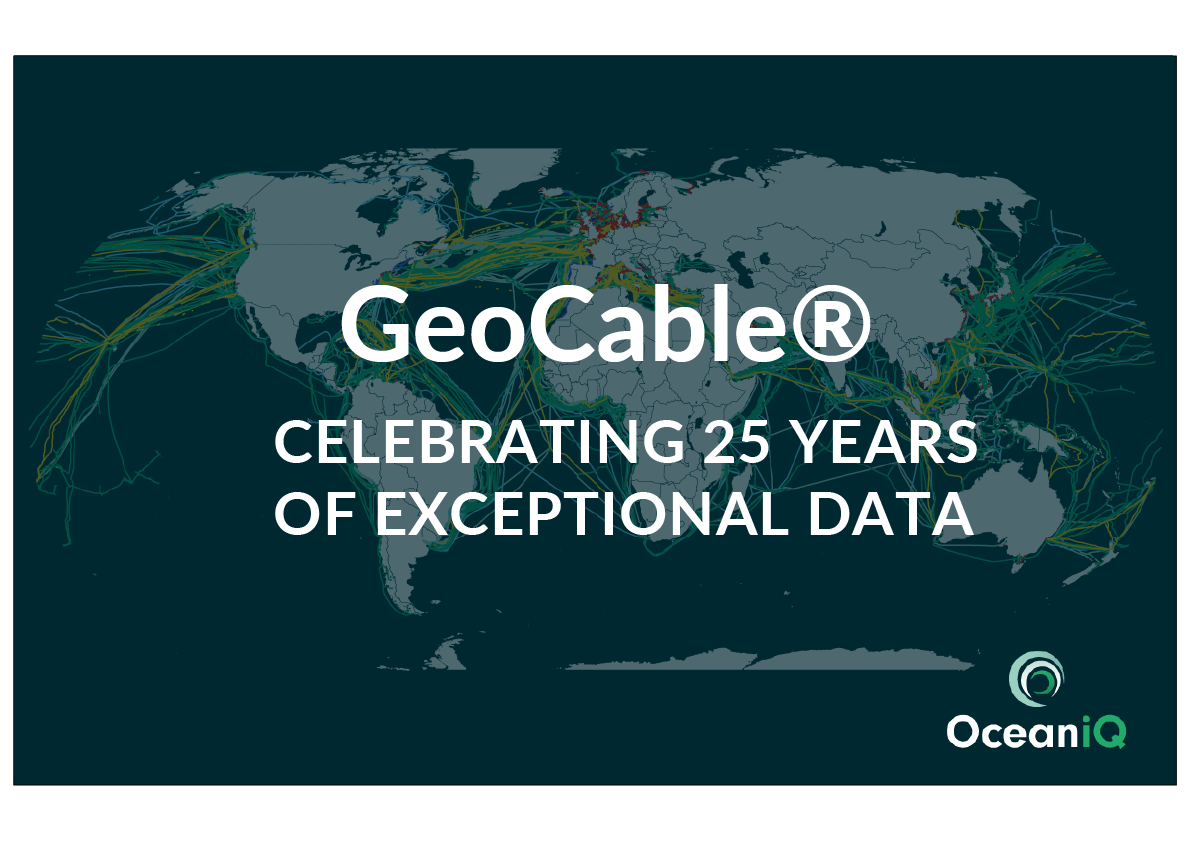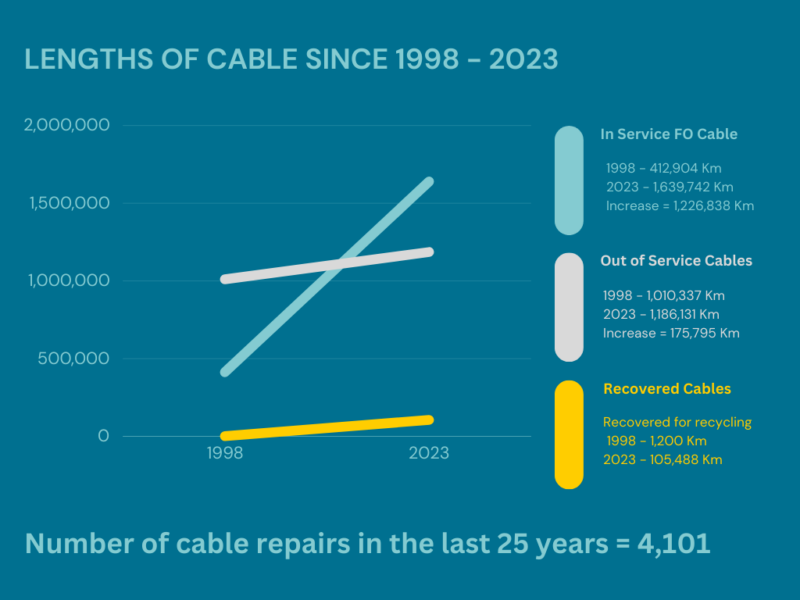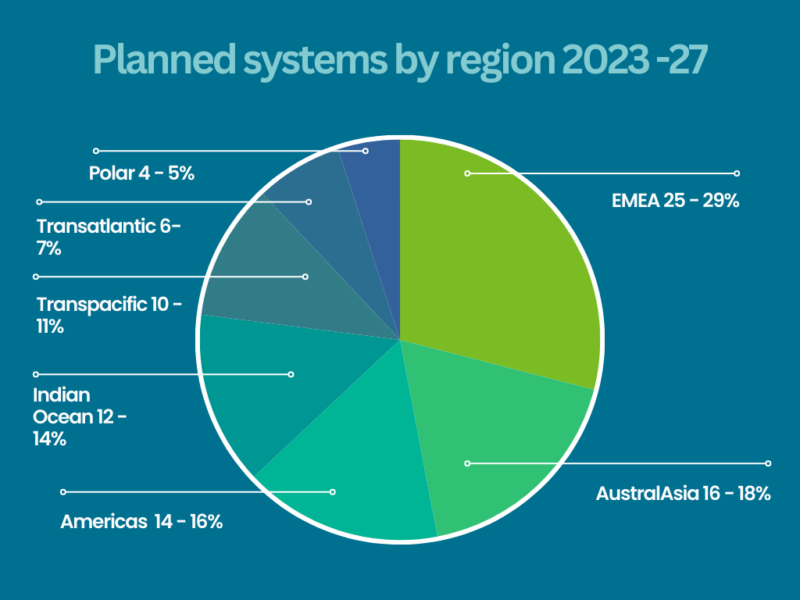The Global Marine Group is pleased to announce the new ownership of the business by Keppel Infrastructure Fund, a fund managed by Keppel.
Contact Us

Celebrating 25 years of exceptional data insight.
The evolution of the submarine cable industry during this timeframe.
For 25 years GeoCable® has been at the forefront of mapping, monitoring, and logging subsea cable installation and faults. GeoCable’s up to date and historical data helps operators plan new cable installations, support repair operations, anticipate potential issues, and improve the overall reliability of a subsea cable system. This valuable resource is indispensable for various stakeholders operating across diverse marine industries, including renewable energy, power, telecoms and survey.
Fibre optic cables continue to play a critical role in global telecommunications, enabling high-speed data transfer and international connectivity. The ongoing expansion and development of subsea cable systems is predicted to continue as the demand for connectivity and data transfer capabilities increases.
Over the last 25 years we have seen a remarkable evolution in subsea fibre optic cables.
Advances in technology have significantly increased the capacity of subsea cables. The adoption of wavelength division multiplexing (WDM) and coherent optical technology has allowed for multiple channels of data to be transmitted simultaneously over a single fibre pair, greatly boosting overall capacity. The development of higher-capacity and higher-speed cables has allowed for faster data transmission rates. This is essential for supporting the growing demand for bandwidth-intensive applications, including video streaming, cloud services, and virtual reality.
With the increasing importance of real-time applications, such as online gaming and financial transactions, there has been a growing emphasis on reducing latency in subsea cable systems. New cables are designed to minimize signal propagation delays.
Even with the advances in technology allowing for ever greater bandwidths in a single cable system this is still not enough to service the insatiable appetite for more and more bandwidth. The number of cables on the seabed has had to increase substantially in the last 25 years to ensure these bandwidth needs are met.
New cables have been deployed to connect continents and regions, enhancing communication and data transfer capabilities. Traditional transatlantic and transpacific routes, have gained additional new cable systems as well as previously underserved or unconnected regions, improving global network redundancy and resilience.

Prediction for cable growth 2023 -2027. Source: SUBMARINE TELECOMS INDUSTRY REPORT 2023 | 2024
Source: SUBMARINE TELECOMS INDUSTRY REPORT 2023 | 2024
Stakeholder diversity – Initially, many subsea cables were owned and operated by telecommunications companies. The increasing demand for data transfer capacity has led to increased investment in subsea cable projects. Governments, private companies, and consortia are investing in the development of new cables to meet the growing global demand for connectivity. Over, the last 25 years, technology companies, consortiums, and private investors have also become key players in the development and ownership of subsea cable systems.
Environmental concerns have become more prominent in recent years. Cable operators are taking measures to minimize the impact of cable installation on marine ecosystems, and there is a focus on developing more environmentally friendly cable materials and deployment methods.
Security Concerns and the importance of securing subsea cables against physical and cyber threats has become a priority. Governments and private entities are increasingly aware of the strategic importance of these cables and the need to protect them from potential disruptions.
Subsea cable faults can result from a variety of factors, ranging from natural phenomena such as seismic activity and adverse weather conditions to human activities such as fishing and anchoring. Efforts to prevent and mitigate these faults involve a combination of careful route planning, improved cable installation techniques, ongoing monitoring, and timely repair operations in the event of a fault.
The Evolution of GeoCable®
OceanIQ has been actively engaged in the installation and upkeep of subsea cables since the inception of the industry in 1850. Over the last 25 years, our specialized team of GIS experts have meticulously curated GeoCable’s exceptional and distinctive dataset. Continuous logging of data related to new and existing cable routes and performance as well as environmental conditions is crucial for post-event analysis and ongoing maintenance. This wealth of historical data is constantly enriched and updated and serves as crucial intelligence for cable owners, installers and maintainers, offering precise details on the extensive 2.8 million km of subsea cables currently on the seabed.
Geocable continues to be an essential tool ensuring the security and integrity of this extensive submarine cable network.
Our Cable Fault Projection Reports leverage our comprehensive database of over 6,500 global cable faults, to produce a report tailored to a specific RPL. This report can identify probable causes and estimate the potential number of faults for a forthcoming cable system The report anonymises historical faults ensuring existing cables are not identified within the analysis providing a valuable tool for the industry in understanding past, present and future fault trends.
OceanIQ takes pride in GeoCable’s unparalleled collection of subsea cable data, which has been carefully maintained and updated over several decades. Recently, the team has broadened the GeoCable® product offerings to meet growing interest from a wider business audience beyond traditional GIS teams. The evolved GeoCable® dataset is now accessible through our complimentary submarine cable map, or via subscription services such as GeoCable®Light or GeoCable®Pro – providing different service levels to meet the needs of all users. For more information about these product offerings click here.

With over 25 years of experience in the industry, overseeing all aspects of Permitting, Charting, SEA Data records management and GIS, OIQ Permitting & GIS Manager – Brian Perratt has gained a wealth of knowledge working on numerous marine projects around the world.

| Cookie | Duration | Description |
|---|---|---|
| bcookie | 2 years | LinkedIn sets this cookie from LinkedIn share buttons and ad tags to recognize browser ID. |
| lang | session | This cookie is used to store the language preferences of a user to serve up content in that stored language the next time user visit the website. |
| lidc | 1 day | LinkedIn sets the lidc cookie to facilitate data center selection. |
| __atuvc | 1 year 1 month | AddThis sets this cookie to ensure that the updated count is seen when one shares a page and returns to it, before the share count cache is updated. |
| __atuvs | 30 minutes | AddThis sets this cookie to ensure that the updated count is seen when one shares a page and returns to it, before the share count cache is updated. |
| __cf_bm | 30 minutes | This cookie, set by Cloudflare, is used to support Cloudflare Bot Management. |
| __hssc | 30 minutes | HubSpot sets this cookie to keep track of sessions and to determine if HubSpot should increment the session number and timestamps in the __hstc cookie. |
| Cookie | Duration | Description |
|---|---|---|
| hubspotutk | 1 year 24 days | This cookie is used by HubSpot to keep track of the visitors to the website. This cookie is passed to Hubspot on form submission and used when deduplicating contacts. |
| uvc | 1 year 1 month | Set by addthis.com to determine the usage of addthis.com service. |
| vuid | 2 years | Vimeo installs this cookie to collect tracking information by setting a unique ID to embed videos to the website. |
| _ga | 2 years | The _ga cookie, installed by Google Analytics, calculates visitor, session and campaign data and also keeps track of site usage for the site's analytics report. The cookie stores information anonymously and assigns a randomly generated number to recognize unique visitors. |
| _gat_UA-178530081-1 | 1 minute | A variation of the _gat cookie set by Google Analytics and Google Tag Manager to allow website owners to track visitor behaviour and measure site performance. The pattern element in the name contains the unique identity number of the account or website it relates to. |
| _gid | 1 day | Installed by Google Analytics, _gid cookie stores information on how visitors use a website, while also creating an analytics report of the website's performance. Some of the data that are collected include the number of visitors, their source, and the pages they visit anonymously. |
| __hstc | 1 year 24 days | This is the main cookie set by Hubspot, for tracking visitors. It contains the domain, initial timestamp (first visit), last timestamp (last visit), current timestamp (this visit), and session number (increments for each subsequent session). |
| Cookie | Duration | Description |
|---|---|---|
| bscookie | 2 years | This cookie is a browser ID cookie set by Linked share Buttons and ad tags. |
| loc | 1 year 1 month | AddThis sets this geolocation cookie to help understand the location of users who share the information. |
| Cookie | Duration | Description |
|---|---|---|
| AnalyticsSyncHistory | 1 month | No description |
| at-rand | never | No description available. |
| ep201 | 30 minutes | This cookie is set by the provider Surveymonkey. This cookie is used for statistical analysis and website optmization. It gathers information on user's interaction with the SurveyMonkey- Widget on thewebsite. |
| ep203 | 3 months | No description available. |
| li_gc | 2 years | No description |
| m | 2 years | No description available. |
| paywallredirect | 1 day | No description |
| UserMatchHistory | 1 month | Linkedin - Used to track visitors on multiple websites, in order to present relevant advertisement based on the visitor's preferences. |